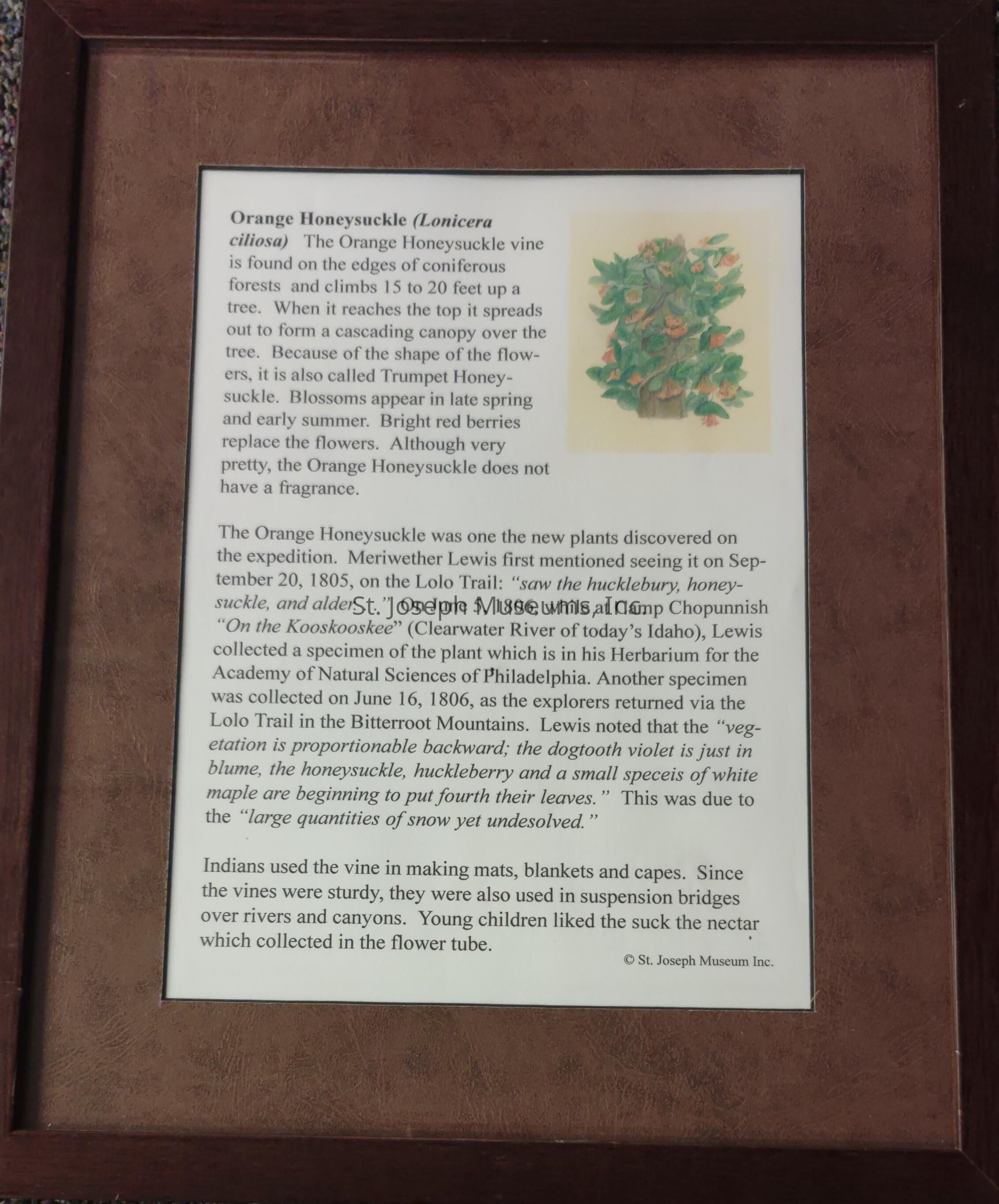Name/Title
Orange Honeysuckle (Lonicera ciliosa)Entry/Object ID
2021.1.29 BScope and Content
Orange Honeysuckle (Lonicera ciliosa) plant description, framed.
The Orange Honeysuckle vine is found on the edges of coniferous forests and climbs 15 to 20 feet up a tree. When it reaches the top it spreads out to form a cascading canopy over the tree. because of the shape of the flowers, it is also called Trumpet Honeysuckle. blossoms appear in late spring and early summer. bright red berries replace the flowers. Although very pretty, the Orange honeysuckle does not have a fragrance.
The Orange Honeysuckle was one the new plants discovered on the expedition. Meriwether Lewis first mentioned seeing it on September 20, 1805, on the Lolo Trail: "saw the hucklebury, honeysuckle, and alder..." On June 5, 1806, while at Camp Chopunnish "On the Kooskooskee" Clearwater River of today's Idaho), Lewis collected a specimen of the plant which is in his Herbarium for the Academy of Natural Sciences of Philadelphia. Another specimen was collected on June 16, 1806, as the explorers returned via the Lolo Trail in the Bitterroot Mountains. Lewis noted that the "vegetation is proportionable backward; the dogtooth violet is just in blume, the honeysuckle, huckleberry and a small speceis of white maple are beginning to put fourth their leaves." This was due to the "large quantities of snow yet undesolved."
Indians used the vine in making mats, blankets and capes. Since the vines were sturdy, they were also used in suspension bridges over rivers and canyons. Young children liked to suck the nectar which collected in the flower tube.Context
Originally designed by the St. Joseph Museum in the fall of 2004. Titled "Botanical Wonders of the Uncharted West. The Recorded Flora of the Lewis & Clark Expedition."Collection
Lewis and ClarkLexicon
LOC Thesaurus for Graphic Materials
Botanical drawings, Expeditions & surveysArchive Items Details
Title
Orange Honeysuckle (Lonicera ciliosa)Creator
Mary L. FletcherDate(s) of Creation
2004Subjects
Plants, Watercolor paintingsParts
Count
2Parts
Watercolor of plant and descriptive label, both framed.Condition
Overall Condition
Very GoodProvenance
Notes
"Botanical Wonders of the Uncharted West" visually depicts how well Lewis followed Jefferson's instructions. In recognition of this achievement, The S. Joseph Museums, Inc. commissioned accomplished artist Mary Fletcher to create fifty (50) selected paintings of flora documented by the Corps during their Journey. These framed watercolor originals are accompanied by similarly framed labels, generated by former Head of Research Jackie Lewin, which describe the corresponding plants with appropriate quotations from the Journals. This collection makes available for study and appreciation plants that were new to Lewis and Clark, but which Native Peoples already recognized as valuable sources of food, medicine, and tools. Some of these still remain a mystery to many, but all will enjoy their beauty, their diverse uses, and their accomplished renderings.
